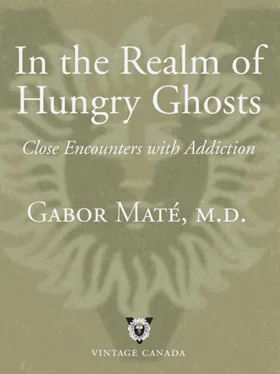Step 1: Re-label
In Step 1 you label the addictive thought or urge exactly for what it is, not mistaking it for reality. I may feel, for example, that I must leave off whatever I’m doing right now and go to the classical music store. The feeling takes on the quality of a need, of an imperative that must immediately be satisfied. Another person will say that she needs to have a chocolate bar immediately or needs to do this or that, depending on the object of the addiction. When we re-label, we give up the language of need. I say to myself: “I don’t need to purchase anything now or to eat anything now; I’m only having an obsessive thought that I have such a need. It’s not a real, objective need but a false belief. I may have a feeling of urgency, but there is actually nothing urgent going on.”
Essential to the first step, as to all the steps, is conscious awareness. It is conscious intention and attention, not just rote repetition that will result in beneficial changes to brain patterns, thoughts and behaviours. Be fully aware of the sense of urgency that attends the impulse and keep labelling it as a manifestation of addiction, rather than any reality that you must act upon. “In Re-labelling,” writes Dr. Schwartz, “you bring into play the Impartial Spectator, a concept that Adam Smith used as the central feature of his book The Theory of Moral Sentiments. He defined the Impartial Spectator as the capacity to stand outside yourself and watch yourself in action, which is essentially the same mental action as the ancient Buddhist concept of mindful awareness.” 1
The point of re-labelling is not to make the addictive urge disappear—it’s not going to, at least not for a long time, since it was wired into the brain long ago. It is strengthened every time you give in to it and every time you try to suppress it forcibly. The point is to observe it with conscious attention without assigning the habitual meaning to it. It is no longer a “need,” only a dysfunctional thought. Rest assured, the urge will come back—and again you will re-label it with determination and mindful awareness. “ Conscious attention must be paid, ” Jeffrey Schwartz emphasizes. “ Therein lies the key. Physical changes in the brain depend for their creation on a mental state in the mind—the state called attention. Paying attention matters.” 2
Step 2: Re-attribute
“In Re-attribute you learn to place the blame squarely on your brain. This is my brain sending me a false message.” 3This step is designed to assign the re-labelled addictive urge to its proper source. In Step 1 you recognized that the compulsion to engage in the addictive behaviour does not express a real need or anything that “must” happen; it’s only a belief. In Step 2 you state very clearly where that urge originated: in neurological circuits that were programmed into your brain long ago, when you were a child. It represents a dopamine or endorphin “hunger” on the part of brain systems that, early in your life, lacked the necessary conditions for their full development. It also represents emotional needs that went unsatisfied.
Re-attribution is directly linked with compassionate curiosity toward the self. Instead of blaming yourself for having addictive thoughts or desires, you calmly ask why these desires have exercised such a powerful hold over you. “Because they are deeply ingrained in my brain and because they are easily triggered whenever I’m stressed or fatigued or unhappy or bored.” The addictive compulsion says nothing about you as a person. It is not a moral failure or a character weakness; it is just the effect of circumstances over which you had no control. What you do have some control over is how you respond to the compulsion in the present. You were not responsible for the stressful circumstances that shaped your brain and worldview, but you can take responsibility now.
Re-attribution helps you put the addictive drive into perspective: it’s no more significant than, say, a momentary ringing in your ear. Just as there is no “bell” that causes the ringing, so there is no real need that the addictive urge will satisfy. It is only a thought, an attitude, a belief, a feeling arising from an automatic brain mechanism. You can observe it consciously, with attention. And you can let it go. There are better sources of dopamine or endorphins in the world, and more satisfying ways to have your needs for vitality and intimacy met.
Once more, don’t allow yourself to be frustrated when what you have let go returns. It will—probably soon. When it does, you will re-label it and re-attribute it: “Hello, old brain circuits,” you say. “I see you’re still active. Well, so am I.” If you change how you respond to those old circuits, you will eventually weaken them. They will persist for a long time—perhaps even all your life, but only as shadows of themselves. They will no longer have the weight, the gravitational pull or the appeal they once boasted. You will no longer be their marionette.
Step 3: Re-focus
In the Re-focus step you buy yourself time. Although the compulsion to open the bag of cookies or turn on the TV or drive to the store or the casino is powerful, its shelf life is not permanent. Being a mind-phantom, it will pass, and you have to give it time to pass. The key principle here, as Dr. Schwartz points out, is this: “ It’s not how you feel that counts; it’s what you do. ”
Rather than engage in the addictive activity, find something else to do. Your initial goal is modest: buy yourself just fifteen minutes. Choose something that you enjoy and that will keep you active: preferably something healthy and creative, but anything that will please you without causing greater harm. Instead of giving in to the siren call of the addiction, go for a walk. If you “need” to drive to the casino, turn on the TV. If you “need” to watch television, put on some music. If you “need” to buy music, get on your exercise bike. Whatever gets you through the night—or at least through the next fifteen minutes. “Early in therapy,” advises Jeffrey Schwartz, “physical activity seems to be especially helpful. But the important thing is that whatever activity you choose, it must be something you enjoy doing.” 4
The purpose of Re-focus is to teach your brain that it doesn’t have to obey the addictive call. It can exercise the “free won’t.” It can choose something else. Perhaps in the beginning you can’t even hold out for fifteen minutes—fine. Make it five, and record it in a journal as a success. Next time, try for six minutes, or sixteen. This is not a hundred-metre dash but a solo marathon you are training for. Successes will come in increments.
As you perform the alternative activity, stay aware of what you are doing. You are doing something difficult. No matter how simple it may seem to others who do not have to live with your particular brain, you know that holding out for even a short period of time is an achievement. You are teaching your old brain new tricks. Unlike the case with old dogs, no one can tell you it can’t be done.
Step 4: Re-value
This step should really be called De-value. Its purpose is to help you drive into your own thick skull just what has been the real impact of the addictive urge in your life: disaster. You know this already, and that is why you are engaged in these four steps. It’s because of the negative impact that you’ve taken yourself by the scruff of the neck and delayed acting on the impulse while you’ve re-labelled and re-attributed it and while you have re-focused on some healthier activity. In this Re-value step you will remind yourself why you’ve gone to all this trouble. The more clearly you see how things are, the more liberated you will be.
Читать дальше












